Types of Cypress Trees: Bald Cypress, Lemon Cypress, and More (Pictures)
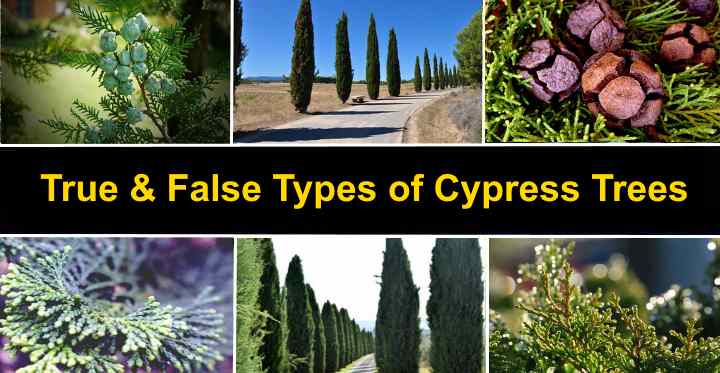
Cypress trees are coniferous trees in the cypress family Cupressaceae. True cypress trees have soft, feathery evergreen foliage and produce cones that look like large acorns.
False cypress trees are evergreen and deciduous coniferous trees that also have the common name cypress. However, they are not from the cypress genus Cupressus.
This article is a guide to the different types of cypress trees. Along with descriptions, pictures of these conifer species will help identify various cypress varieties.
False Cypress Vs. True Cypress
True cypress trees belong to the coniferous plant genus Cupressus. Cypress trees such as the Monterey cypress (Cupressus macrocarpa) are large trees that grow in the Northern Hemisphere.
False cypress trees are conifers that have the common name cypress but are not in the Cupressus genus. The bald cypress (Taxodium distichum) and Pond Cypress (Taxodium ascendens) are examples of false cypresses. The Hinoki cypress (Chamaecyparis obtusa) and Lawson Cypress (Chamaecyparis lawsoniana) are other false cypress varieties.
This article will look at the various features of many trees with the common name cypress. You’ll find conifers from the plant genera Cupressus, Chamaecyparis, and Taxodium.
Cypress Trees in Florida
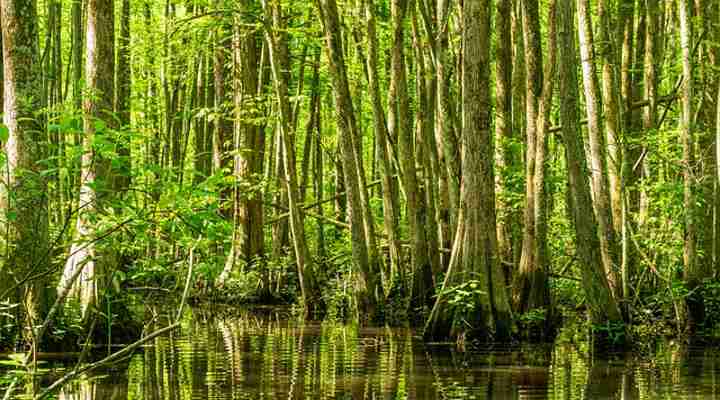
The pond cypress and bald cypress are native to the swampy areas of Florida
Two types of cypress trees grow throughout Florida—the pond cypress and bald cypress. The native Florida cypress trees are deciduous conifers that grow in swampy areas. You will often see Florida’s cypress trees growing in the everglades, with their large swollen trunk bases surrounded by water.
Planting a Cypress Tree
Plant small or dwarf cypress trees, such as dwarf Hinoki cypress or dwarf lemon cypress, in a front or backyard as a low-maintenance privacy hedge, evergreen screen, or specimen tree. The best place for planting cypress trees is in full sun to partial shade and loamy, well-draining soil. Water the tree once a week in the summer. These easy-care coniferous plants are fairly drought-resistant and require little pruning.
Other types of cypress trees are too large for most home gardens and are used in parks or large yards.
Types of Cypress Trees (With Pictures)
Let’s look in detail at the most popular cypress trees you can plant in your garden landscape. You’ll also find the best low-growing cypress trees and shrubs for foundation planting, corner plants, or natural privacy screens.
Here are some of the many types of cypress trees.
Monterey cypress (Cupressus macrocarpa)
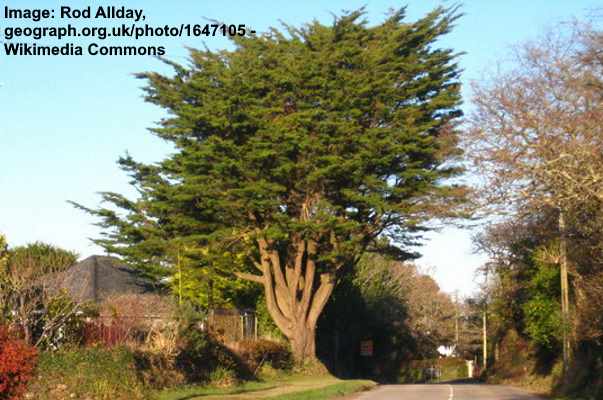
Monterey cypress (Cupressus macrocarpa)
Monterey cypress trees are medium-sized conifers that are native to California. The cypress has a recognizable flat top that spreads out sideways. The Californian cypress trees grow up to 130 ft. (40 m) tall. These native cypress trees also grow in Europe, New Zealand, and some African countries.
Monterey cypress trees have soft, scale-like bright green leaves that give off a lemony scent when crushed. Monterey cypress trees have rough, fibrous bark that is gray color and starts to peel in strips as the tree matures. The conifer cones from Monterey cypresses are oblong and grow up to 1.5” (4 cm) long.
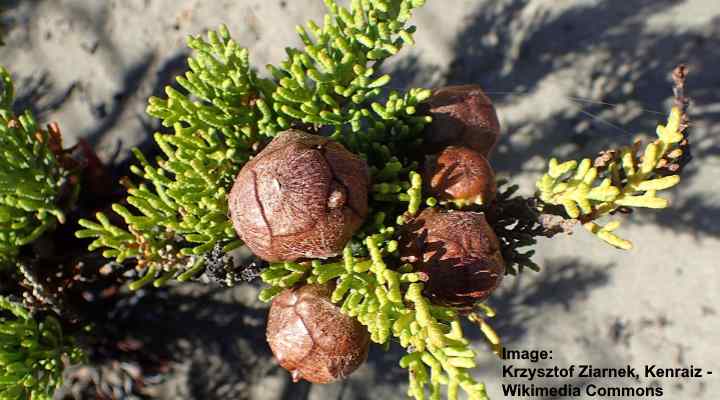
Monterey cypress leaves and cones
- Growing zones: 7 to 11
- Location: Full sun to partial shade
- Size: 40 – 70 ft. (12 – 21 m) but can grow up to 130 ft. (40 m)
Lemon Cypress Trees (Cupressus macrocarpa ‘Goldcrest’)
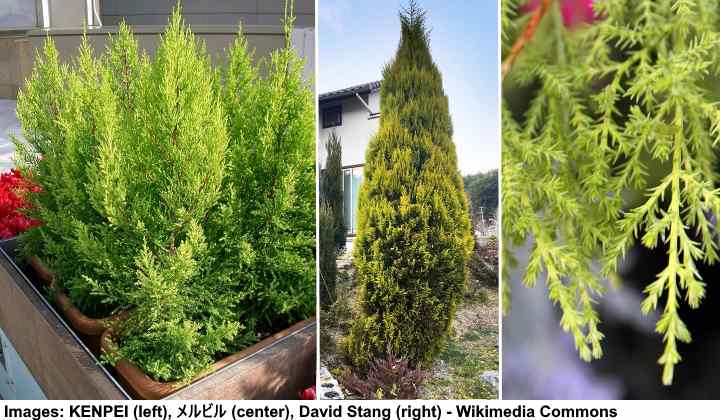
Lemon Cypress Trees (Cupressus macrocarpa ‘Goldcrest’)
Lemon cypress trees are popular garden landscape trees. These cypress trees have bright, golden yellow soft leaves that keep their color throughout the winter. The tree’s bark is scaly, and it flakes as the tree matures. Cones are small and spherical. Fast-growing lemon cypress trees are narrow columnar trees with branches that grow upward.
Lemon cypress trees are a cultivar of Monterey cypress trees. Similar to the tree species, the branches of lemon cypress have an irregular growth habit.
The Cupressus macrocarpa ‘Goldcrest’ has rapid growth, growing at about 10” (25 cm) per year. The lemon cypress reaches between 10 and 16 ft. (3 – 5 m) in 10 years. It gets its full height of 32 – 40 ft. (10 – 12 m) within 20 years.
One reason the lemon cypress tree is so popular is that it requires little maintenance. The soft conifer keeps its columnar shape without pruning. The only reason to prune the tree is for height control.
The common name of lemon cypress comes from its citrus-scented foliage. Crushing the soft, feather-like leaves of lemon cypress gives off a pungent lemony scent.
Plant lemon cypress trees as a privacy screen, natural hedge, or corner planting. The elegant cypress tree also grows well as a specimen tree and is suitable for Mediterranean or coastal gardens.
- Growing zones: 7 to 11
- Location: Full sun
- Size: 35 – 40 ft. (10.5 – 12 m)
How to Care for Lemon Cypress Outdoors
Lemon cypress trees are easy to grow in a front or backyard. You should plant your outdoor cypress in a sunny location in well-drained soil. Because these trees are low-maintenance, they are relatively tolerant of drought. However, until the lemon cypress is established, you should water it twice a week.
How to Care for Lemon Cypress Indoors
Lemon cypress trees grow well indoors in containers. It’s vital to plant the tree in a light, well-draining potting mix and drench the soil whenever it is partially dry.
There are two essential care factors when growing lemon cypress trees indoors. First, they need at least six hours of sunlight daily. Second, they grow best in cool temperatures in winter—around 60°F (15°C).
Dwarf Lemon Cypress (Cupressus macrocarpa ‘Goldcrest Wilma’)
If you’re looking for a miniature cypress tree, choose the dwarf ‘Goldcrest Wilma’ cultivar. This short tree only grows up to 3 ft. (1 m) and keeps its bright, yellow foliage throughout the year. Put the potted cypress in a sunny indoor location, protected from direct sunlight and water whenever the top layer of soil dries out.
Bald Cypress (Taxodium distichum)
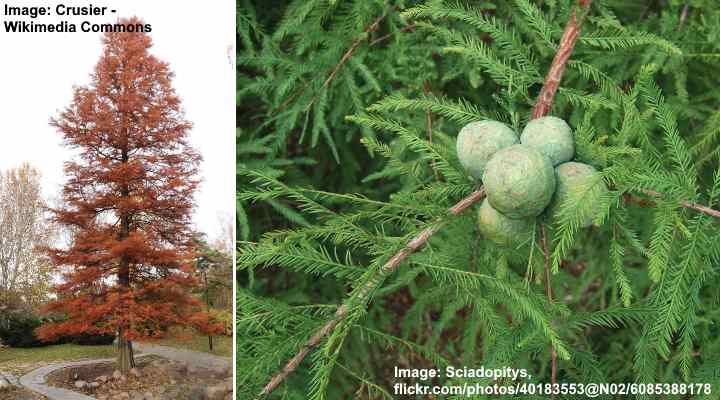
Bald cypress (Taxodium distichum) tree, foliage and cones
Bald cypress trees are native to the swampy marshes of Florida. Bald cypresses are deciduous conifer trees that lose their foliage in winter—hence the name ‘bald.’ The vast trees thrive in wet conditions but can also survive dry soil. Bald cypress trees grow to between 50 and 70 ft. (15 – 21 m) tall.
Florida’s bald cypress trees have upright growth and a triangular shape. You can plant the large trees in a sizeable residential garden that has moist, sandy soil. The moisture-loving tree is ideally suited to growing in wet soils or near water.
A common feature of bald cypress trees is the roots that grow around the tree (“knees”). These odd growths are parts of the tree’s root. Some roots grow up to 6 ft. (2 m) tall. Because of this fact, bald cypress trees are not a common garden tree as it’s easy to trip on the roots.
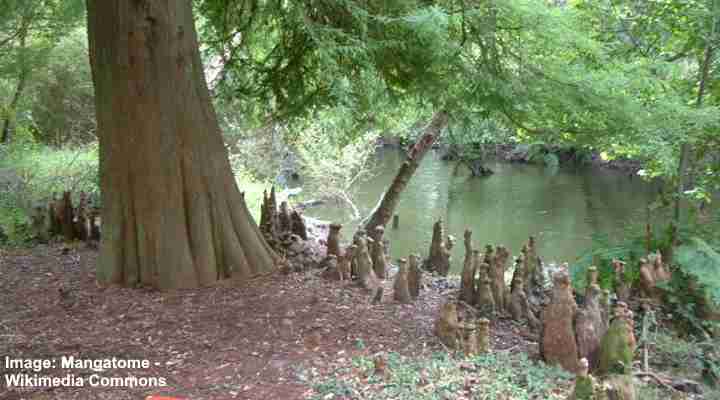
Bald cypress roots
- Growing zones: 4 to 9
- Location: Full sun
- Size: 50 – 70 ft. (15 – 21 m)
Pond Cypress (Taxodium ascendens)
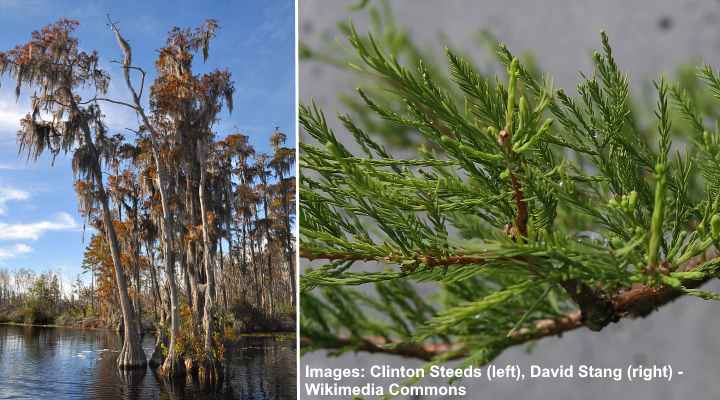
Pond Cypress (Taxodium ascendens) trees and foliage
Pond cypress trees are the other species of Florida’s cypresses. Pond cypress are false cypress trees that have a narrow, columnar shape and grow to between 50 and 60 ft. (15 – 18 m) tall. The identifying features of pond cypress are sprays of soft green foliage that turn orange or golden-brown in the fall. When growing in water or marshes, the tree’s trunk has a recognizable swollen base.
Pond cypress trees are better for home gardens than bald cypress trees. These pseudo-cypress trees have a compact growth and rarely produce “knees.” The only maintenance is light pruning to remove dead branches. Despite the fact the trees grow in standing water—hence the name pond cypress—they are surprisingly drought-tolerant.
- Growing zones: 5 to 9
- Location: Full sun to partial shade
- Size: 50 – 60 ft. (15 – 18 m)
Mediterranean Cypress or Italian Cypress (Cupressus sempervirens)
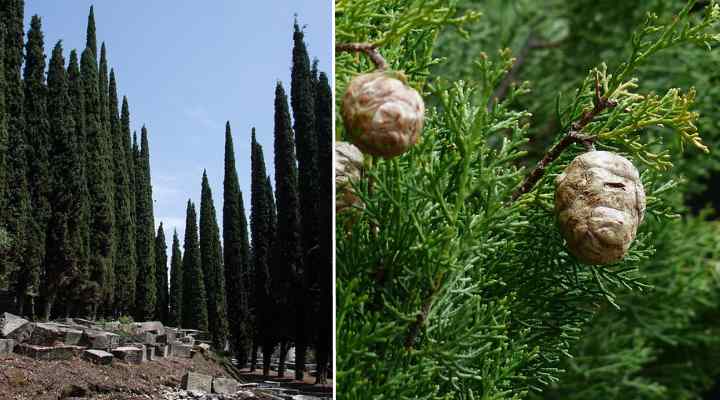
Mediterranean Cypress / Italian Cypress (Cupressus sempervirens) trees, foliage and cones
Mediterranean cypress trees are tall, skinny conifers with feathery sprays of soft evergreen foliage. The green leaves of these European cypress trees are scale-like and grow on rounded shoots. The seed cones look like brown, ovoid balls up to 1.5” (4 cm) long.
When fully grown, Mediterranean cypress trees have an appearance of tall green columns that taper to a point.
Italian cypress trees are ideal for planting as specimen plants to add vertical height to garden landscapes. The drought-tolerant columnar trees need planting in well-draining soil where they get plenty of sunshine.
- Growing zones: 7 to 9
- Location: Full sun
- Size: 40 – 70 ft. (12 – 21 m)
Hinoki Cypress (Chamaecyparis obtusa)
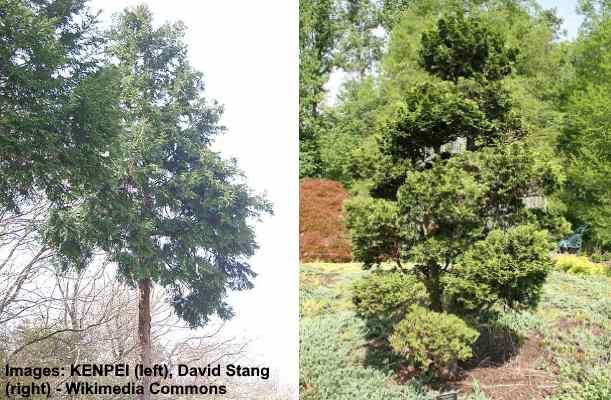
Hinoki Cypress (Chamaecyparis obtusa) on the left image and ‘Nana Gracilis’ cultivar on the right
Hinoki cypress trees are slow-growing evergreen conifers with a pyramidal shape. These cypress trees have dark-green leaves that droop at the ends. Mature hinoki trees have reddish bark that starts to peel as the tree matures. The species tree Chamaecyparis obtusa is usually too large for residential gardens.
There are many dwarf or miniature hinoki cypress trees that are ideal for garden landscapes. For example, the ‘Nana Gracilis’ cultivar grows between 3 and 6 ft. (1 – 2 m) tall. The false cypress has glossy dark green foliage and broad conical growth. Grow dwarf hinoki cypresses as privacy hedges, container plants, foundation plants, or a specimen plant.
- Growing zones: 4 to 8
- Location: Full sun
- Size: 50 – 75 ft. (15 – 22 m)
Arizona Cypress (Cupressus arizonica)
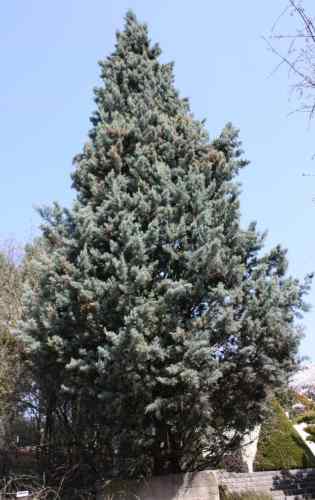
Arizona cypress var. glabra Fastigiata
Arizona cypress trees have a triangular growth shape, making them ideal Christmas trees. The Cupressus arizonica has dense foliage, made up of dull green or blue-green feathery scale-like leaves. Arizona cypresses have small, oblong cones. The fast-growing evergreen grows at a rate of 12” (30 cm) per year.
- Growing zones: 6 to 9
- Location: Full sun
- Size: 40 – 70 ft. (12 – 21 m)
Leyland Cypress Tree (Cupressus x leylandii)
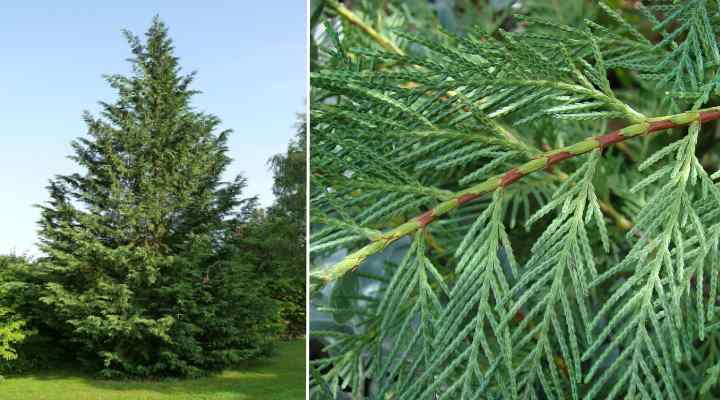
Leyland Cypress (Cupressus x leylandii) tree and leaves
Leyland cypress trees have dense foliage, broad columnar growth in the shape of a pyramid. Leyland cypress has rapid growth and can grow between 18” and 36” (45 – 90 cm) annually. These features of Leyland cypress trees make them perfect plants for privacy screens or evergreen hedges.
Plant Leyland cypress trees in full sun, side by side, to create a natural, living hedge. You can grow a natural, evergreen barrier between 6 ft. and 22 ft. (2 – 7 m) tall to add privacy to a backyard.
Leyland cypress trees are a hybrid tree of the Nootka cypress (Cupressus nootkatensis) and Monterey cypress (Cupressus macrocarpa).
- Growing zones: 6 to 10
- Location: Full sun
- Size: 6 – 22 ft. (2 – 7 m); however, without pruning, the tree can grow up to 70 ft. (21 m)
Nootka Cypress (Cupressus nootkatensis)

‘Pendula’ Nootka cypress
Nootka cypress trees are native to North America. The evergreen cypress trees have flat, dark-green sprays with scale-like leaves. An identifying feature of Nootka cypresses is their weeping growth and drooping branches. Nootka cypress trees grow up to 103 ft. (40 m). Because the tall trees are too large for many backyards, it’s better to plant a dwarf Nootka cypress cultivar.
Other names for Nootka cypress trees include yellow cedar, Alaska cedar, yellow cypress, and Nootka cedar.

Nootka cypress ‘Glauca’ (left) and ‘Green Arrow’ (right)
Examples of impressive Nootka cypress cultivars:
- ‘Pendula’ Nootka cypress. This weeping cypress tree has sprays of evergreen foliage drooping from branches. The fast-growing cypress thrives in full sun or part shade. The stunning cypress tree grows to between 20 and 35 ft. (6 – 10.5 m) high.
- ‘Green Arrow’ Nootka cypress. A majestic weeping cypress with thin, columnar growth. The weeping branches almost hang vertically from the trunk. Plant the cypress in zones 4 to 8 and in full to partial sun. The ‘Green Arrow’ cypress grows to between 18 and 35 ft. (5 – 11 m) tall.
- ‘Glauca’ Nootka cypress. The beautiful conical Nootka cypress ‘Glauca’ has dense blue-green evergreen foliage. The fast-growing tree has a growth rate of 1 ft. (30 cm) per year. This easy-care cypress thrives in full sun and grows up to 25 ft. (7 m)
Lawson Cypress (Chamaecyparis lawsoniana)
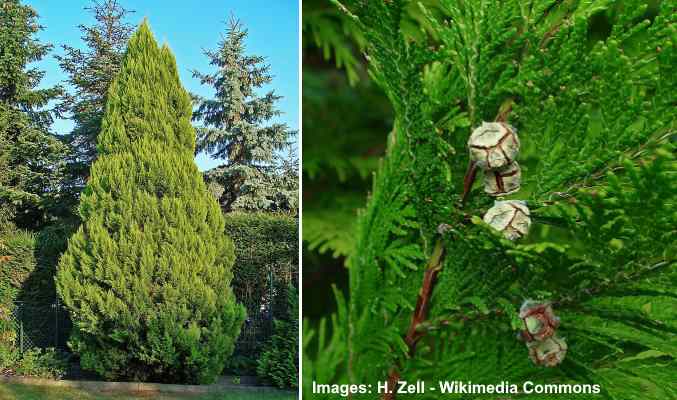
Lawson Cypress (Chamaecyparis lawsoniana) tree, foliage and cones
Also called Port Orford cedars, the Lawson cypress is a tall evergreen tree. The green or bluish-green foliage is made from flat, feathery sprays and scale-like cypress leaves. The cypress species tree grows up to 200 ft. (60 m) tall—probably too tall for most gardens. So, if you want to plant a Lawson cypress in your backyard, it would be best to look for a smaller dwarf or miniature coniferous shrub.

Lawson’s cypress ‘Ellwoodii’
Here are some stunning dwarf Lawson cypress cultivars:
- ‘Ellwoodii’ Lawson cypress. This columnar cypress shrub with dense foliage has soft, feathery silvery-blue leaves. This cypress hedge plant is best growing as a privacy hedge or specimen tree. Lawson cypress trees thrive in zones 5 to 8, full sun, and loamy soil. Ellwoodii cypress trees grow to between 13 and 20 ft. (4 – 6 m) tall.
- ‘Silver Thread’ Lawson cypress. This dwarf false cypress tree has a narrow growth habit and triangular shape. Perfect for small gardens, the miniature cypress grows to between 3 and 5 ft. (1 – 1.5 m) tall. Plant in full sun in well-draining soil to enjoy its light green foliage throughout the year.
- ‘Minima Glauca’ Lawson cypress. This tiny cypress shrub is ideal for planting as a foundation plant, low-growing hedge, border plant, or specimen plant. The dwarf false cypress tree has a rounded growth habit, densely-growing leaves, and bluish-green foliage. This miniature cypress won’t grow taller than 3 ft. (1 m).
Chinese Weeping Cypress (Cupressus funebris)
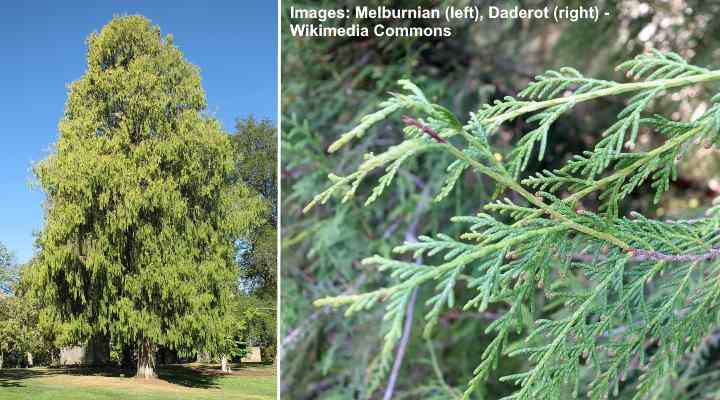
Chinese weeping cypress (Cupressus funebris) tree and foliage
Chinese weeping cypress trees are medium-sized conifers with light green foliage. Also called the mourning cypress, this conifer tree has a weeping appearance due to pendulous branches hanging off the tree. This growth habit makes the Chinese weeping cypress a highly ornamental evergreen tree. The weeping cypress is often planted in public parks or extensive gardens.
- Growing zones: 7 to 10
- Location: Full sun to partial shade
- Size: 20 – 35 ft. (6 – 10 m)
Related articles:
